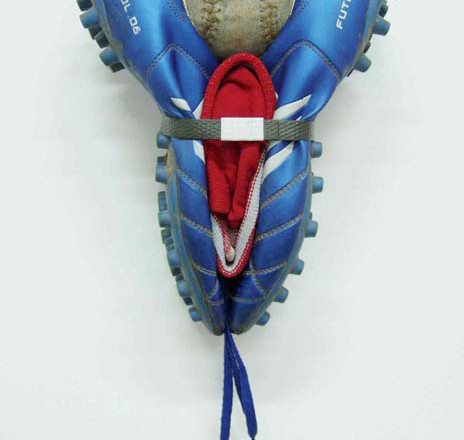


Carlos Herrera
Born in 1976 in Rosario, Argentina, Carlos Herrera lives and works in Argentina.
He is a graduate of the universities of Buenos Aires, Lima and Sante-Fe.
He is represented by the Ruth Benzacar gallery (Buenos-Aires).
Statement
Carlos Herrera places an importance on the symbolic value of the items that he collects and assembles for the production of his sculptural works. Poor, everyday objects, without obvious qualities, albeit bearers of a rich memory of meaning come together and play an important role in his work. Their layout results in a focusing effect and the viewer’s attention is drawn to the components of the work. Thus, Autorretrato sobre mi muerte, 2009/2011 (Self-portrait of my death) consists of a common, transparent, plastic bag placed on the ground, containing some of the artist’s favourite items, including shoes with two dead squid in a state of decomposition. The work reflects the artist’s feelings on death, his own death in particular. This piece, inspired by a personal story, carries questions of a universal nature. This way of working reminds us of the approach of Cuban artist, Felix Gonzalez-Torres, active in the 1990s, who, in his works, confers an autobiographical role to the objects he recycles as artistic materials.
Untitled, 2011
Temperatura Perfecta series, sculpture
Shoes, clothe, baseball ball
28 x 25 x 14 cm / Unique Piece
Acquisition in 2012
Untitled is a sculpture produced from used sports material. Football boots, a ball and socks are mounted on a wall and arranged in a colourful, symmetrical and harmonious layout. Evocative of Argentinean sports culture, particularly football, the objects appear like trophies. Frequent in contemporary sculpture, the reusing of pre-existing ready-made objects is considered here in a unique way. Indeed, unlike simulationist artists like Haim Steinbach or Jeff Koons with his early sculptures which made use of commercial items, the objects used here are not new and show signs of wear and tear, reminding us of their original function. The almost decorative validation or enhancement conferred onto these “poor” objects gives rise to a paradox. The tension produced by the binding together of the objects counterbalances the corporeal or sensual energy of sport. Nevertheless the patina – even the dirt, symbolizing physical effort – add an almost fetishist dimension to the work.